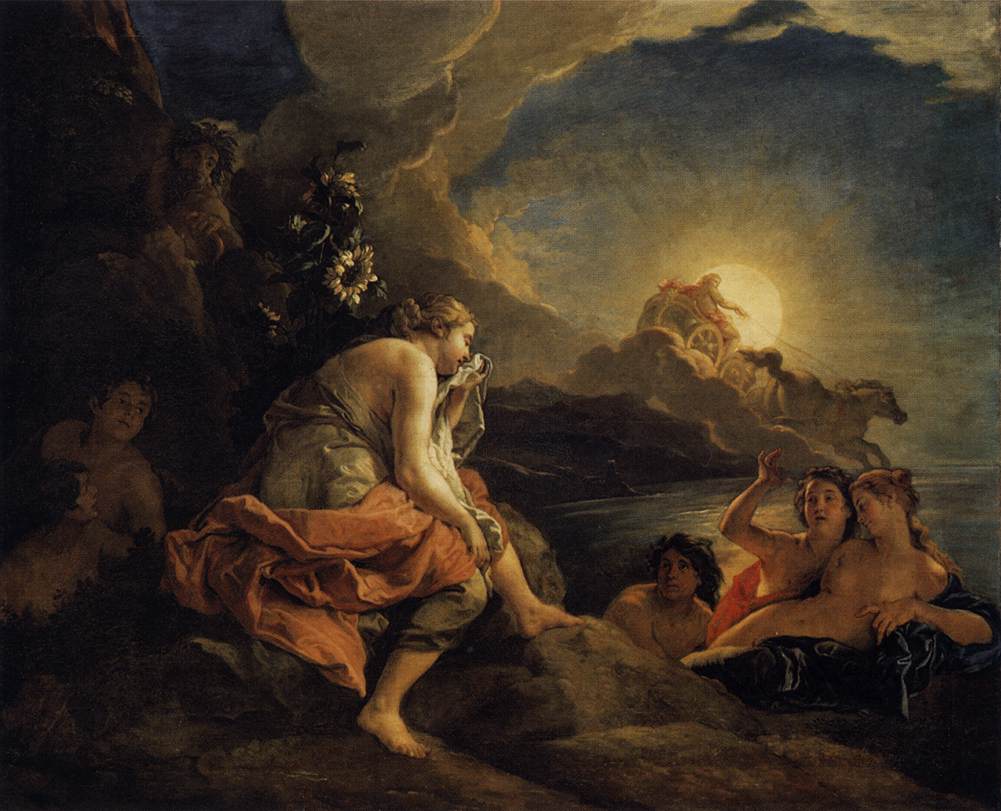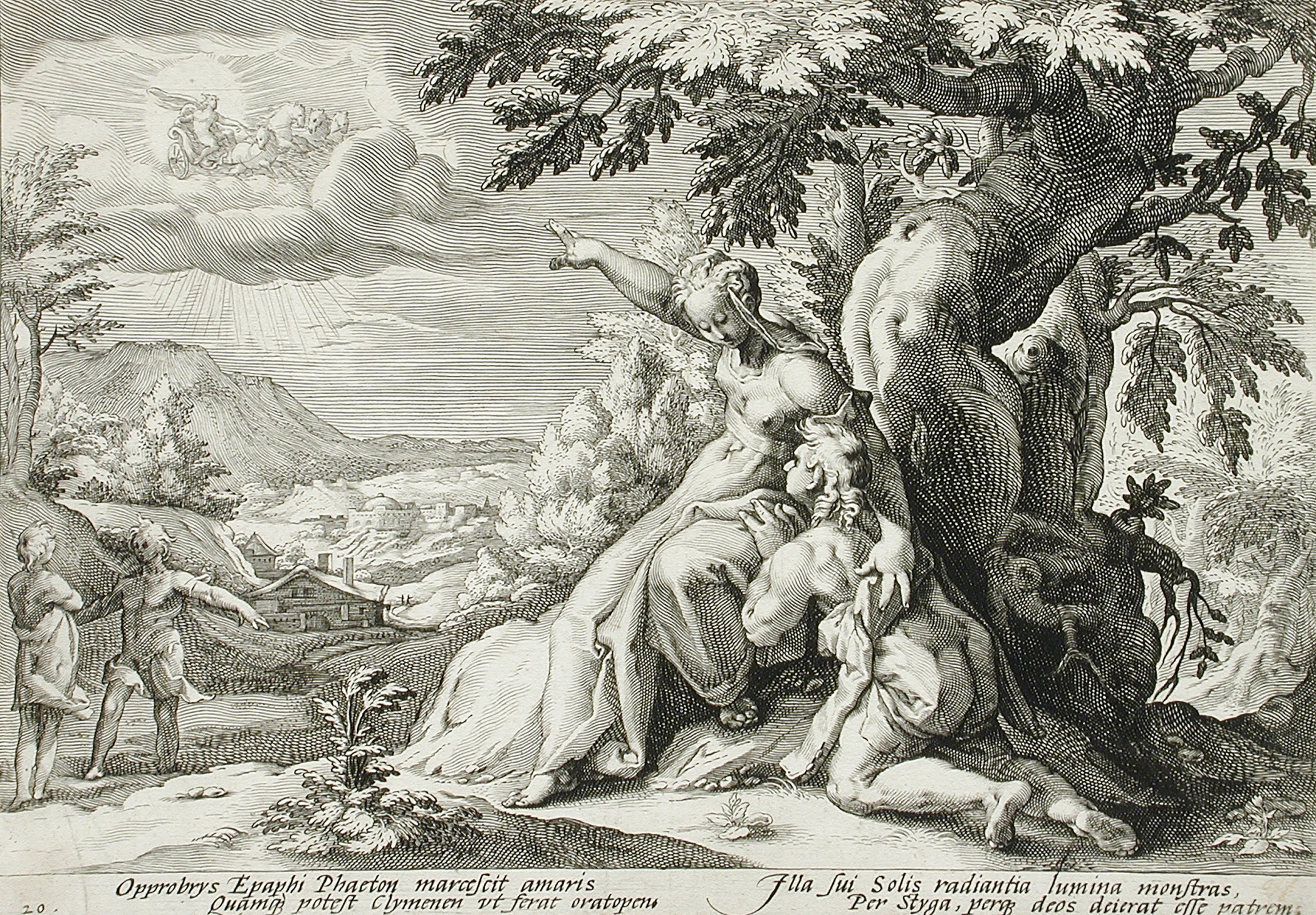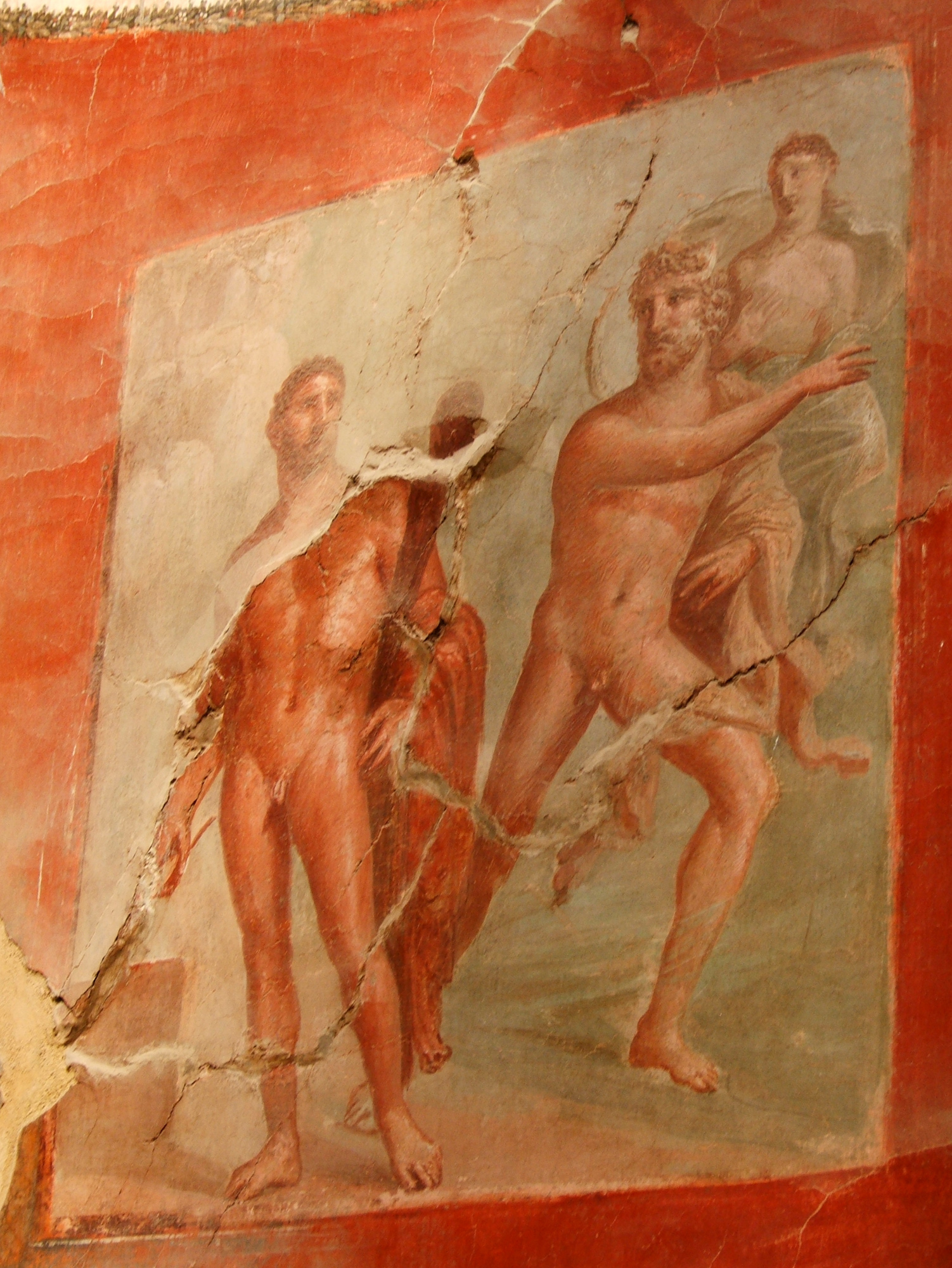|
Helius
In ancient Greek religion and mythology, Helios (; grc, , , Sun; Homeric Greek: ) is the god and personification of the Sun (Solar deity). His name is also Latinized as Helius, and he is often given the epithets Hyperion ("the one above") and Phaethon ("the shining"). Helios is often depicted in art with a radiant crown and driving a horse-drawn chariot through the sky. He was a guardian of oaths and also the god of sight. Though Helios was a relatively minor deity in Classical Greece, his worship grew more prominent in late antiquity thanks to his identification with several major solar divinities of the Roman period, particularly Apollo and Sol. The Roman Emperor Julian made Helios the central divinity of his short-lived revival of traditional Roman religious practices in the 4th century AD. Helios figures prominently in several works of Greek mythology, poetry, and literature, in which he is often described as the son of the Titans Hyperion and Theia and brother of th ... [...More Info...] [...Related Items...] OR: [Wikipedia] [Google] [Baidu] |
Theia
In Greek mythology, Theia (; grc, Θεία, Theía, divine, also rendered Thea or Thia), also called Euryphaessa ( grc, Εὐρυφάεσσα) "wide-shining", is one of the twelve Titans, the children of the earth goddess Gaia and the sky god Uranus. She is the Greek goddess of sight and vision, and by extension the goddess who endowed gold, silver and gems with their brilliance and intrinsic value. Her brother-consort is Hyperion, a Titan and god of the sun, and together they are the parents of Helios (the Sun), Selene (the Moon), and Eos (the Dawn). She seems to be the same with Aethra, the consort of Hyperion and mother of his children in some accounts. Like her husband, Theia features scarcely in myth, being mostly important for the children she bore, though she appears in some texts and rare traditions. Etymology The name ''Theia'' alone means simply "goddess" or "divine"; ''Theia Euryphaessa'' () brings overtones of extent (, ''eurys'', "wide", root: ) and brightness ... [...More Info...] [...Related Items...] OR: [Wikipedia] [Google] [Baidu] |
Selene
In ancient Greek mythology and religion, Selene (; grc-gre, Σελήνη , meaning "Moon"''A Greek–English Lexicon's.v. σελήνη) is the goddess and the personification of the Moon. Also known as Mene, she is traditionally the daughter of the Titans Hyperion and Theia, and sister of the sun god Helios and the dawn goddess Eos. She drives her moon chariot across the heavens. Several lovers are attributed to her in various myths, including Zeus, Pan, and the mortal Endymion. In post-classical times, Selene was often identified with Artemis, much as her brother, Helios, was identified with Apollo. Selene and Artemis were also associated with Hecate and all three were regarded as moon and lunar goddesses, but only Selene was regarded as the personification of the Moon itself. Her Roman equivalent is Luna. Names and etymology The name "Selene" is derived from the Greek noun ''selas'' ('), meaning "light, brightness, gleam". In the Doric and Aeolic dialects, her nam ... [...More Info...] [...Related Items...] OR: [Wikipedia] [Google] [Baidu] |
Clytie (Oceanid)
Clytie (; grc, Κλυτίη, Klutíē), or Clytia (; grc, Κλυτία, Klutía) is a water nymph, daughter of the Titans Oceanus and Tethys in Greek mythology. She is thus one of the 3,000 Oceanid nymphs, and sister to the 3,000 Potamoi (the river-gods). According to the myth, Clytie loved the god of the sun Helios in vain, but he left her for another woman, the princess Leucothoe, under the influence of Aphrodite, the goddess of love. In anger and bitterness, she revealed their affair to the girl's father, indirectly causing her doom as the king buried her alive. This failed to win Helios back to her, and she was left lovingly staring at him from the ground; eventually she turned into a heliotrope, a violet flower that gazes at the Sun in its diurnal journey. Clytie's story is mostly known from and fully preserved in Ovid's narrative poem ''Metamorphoses'', though other brief accounts and references to her from other authors survive as well. Etymology Her name, spell ... [...More Info...] [...Related Items...] OR: [Wikipedia] [Google] [Baidu] |
Boswellia Sacra
''Boswellia sacra'' (commonly known as frankincense or olibanum-tree) is a tree in the Burseraceae family. It is the primary tree in the genus ''Boswellia'' from which frankincense, a resinous dried sap, is harvested. It is native to the Arabian Peninsula (Oman, Yemen), and horn of Africa (Somalia). Description This species of ''Boswellia'' is a small deciduous tree, which reaches a height of , with one or more trunks. Its bark has the texture of paper and can be removed easily. It has compound leaves and an odd number of leaflet (botany), leaflets, which grow opposite to one another along its branches. Its tiny flowers, a yellowish white, are gathered in axillary clusters composed of five petals, ten stamens and a cup with five teeth. The fruit is a capsule (botany), capsule about long. The new leaves are covered with a fine down. Individual trees growing on steep slopes tend to develop some buttress root, buttressing that extends from the roots up into the base of the stem. T ... [...More Info...] [...Related Items...] OR: [Wikipedia] [Google] [Baidu] |
Clymene (mother Of Phaethon)
In Greek mythology, Clymene or Klymene (; grc, Κλυμένη, ''Kluménē'') was the name of an Oceanid nymph loved by the sun god Helios and the mother by him of Phaethon and the Heliades. In most versions, Clymene is the one to reveal to Phaethon his divine parentage and encourage him to seek out his father, and even drive his solar chariot. Etymology (''Kluménē'') is the feminine form of (''Klúmenos''), meaning "famous". It thus shares the same root and meaning as "Clytie", another Oceanid nymph whom Helios loved. Family Clymene is one of the three hundred Oceanid daughters of Oceanus and Tethys.Tzetzes, ''Chiliades'4.19/ref> Although she shares name and parentage with Clymene, the wife of Iapetus, who is also a daughter of Oceanus and Tethys (and thus one of her sisters), she is distinguished from her. Byzantine writer John Tzetzes recorded an alternative genealogy where Clymene is the mother of a boy named Phaethon by Helios, but not the Phaethon who drov ... [...More Info...] [...Related Items...] OR: [Wikipedia] [Google] [Baidu] |
Aegle (mythology)
Aegle ( grc, Αἴγλη "brightness" or "dazzling light") is the name of several different figures in Greek mythology: *Aegle, one of the daughters of Asclepius by Lampetia, the daughter of the Sun, according to Hermippus. Her name is said to have derived from "Αἴγλη" ("Aegle"), meaning "Brightness," or "Splendor," either from the beauty of the human body when in good health, or from the honor paid to the medical profession. *Aegle, the most beautiful of the Naiads, daughter of Zeus and Neaera, by whom Helios begot the Charites. *Aegle, one of the Heliades, a sister of Phaeton, and daughter of Helios and Clymene. In her grief at the death of her brother she and her sisters were changed into poplars. *Aegle, one of the Hesperides. *Aegle, another name of Coronis, daughter of Phlegyas and lover of Apollo.Isyllus, ''Hymn to Asclepius'128.37 ff./ref> *Aegle, was a daughter of Panopeus, the Phocian hero. She was said to be one who was beloved by Theseus, and for whom he forso ... [...More Info...] [...Related Items...] OR: [Wikipedia] [Google] [Baidu] |
Aegiale (daughter Of Helios)
In Greek mythology, Aegiale (Ancient Greek: ) was the daughter of Helios and Clymene, and a member of the Heliades. She was the mother of Alcyone by Aeolus. But some accounts, makes Enarete the mother of Aeolus's children.Apollodorus1.7.3/ref> Notes References * Apollodorus, ''The Library'' with an English Translation by Sir James George Frazer, F.B.A., F.R.S. in 2 Volumes, Cambridge, MA, Harvard University Press; London, William Heinemann Ltd. 1921. Online version at the Perseus Digital Library. *Bell, Robert E., ''Women of Classical Mythology: A Biographical Dictionary''. ABC-Clio. 1991. . * |
Aega (mythology)
In Greek mythology, Aega (Ancient Greek: Αίγη) or Pine or Cynosura or Melissa was, according to Hyginus, a daughter of Olenus, who was a descendant of Hephaestus. Aega and her sister Helice nursed the infant Zeus in Crete, and the former was afterwards changed by the god into the constellation called Capella. Mythology According to other traditions mentioned by Hyginus, Aega was a daughter of Melisseus, king of Crete, and was chosen to suckle the infant Zeus; but as she was found unable to do it, the service was performed by the goat Amalthea. Hyginus also reports a tradition that while married to Pan she had a son by Zeus whom she called Aegipan. According to other authors, Aega was a daughter of Helios and of such dazzling brightness that the Titans in their attack upon Olympus became frightened and requested their mother Gaia to conceal her in the earth. She was accordingly confined in a cave in Crete, where she became the nurse of Zeus. In the Titanomachy, Zeus wa ... [...More Info...] [...Related Items...] OR: [Wikipedia] [Google] [Baidu] |
Aeëtes
Aeëtes (; , ; , ), or Aeeta, was a king of Colchis in Greek mythology. The name comes from the ancient Greek word (, "eagle"). Family Aeëtes was the son of Sun god Helios and the Oceanid Perseis, brother of Circe, Perses and Pasiphaë, and father of Medea, Chalciope and Absyrtus. His consort was either (1) Idyia, the youngest daughter of Oceanus, (2) Asterodeia, a Caucasian Oceanid, (3) the Nereid Neaera, (4) Clytia, (5) Ipsia or Eurylyte. According to others, he was the brother of Perses, a king of Tauris, husband of his niece Hecate, and father of Medea, Chalciope and Absyrtus. Yet other versions make Aeëtes a native of Corinth and son of Ephyra, an Oceanid, or else of a certain Antiope. Asterope was also one of the possible mothers of Aeëtes. Mythology Foundation of Colchis Pausanias states that, according to the poet Eumelos, Aeëtes was the son of Helios (from northern Peloponnesus) and brother of Aloeus. Helios divided the land he ruled, and he gave ... [...More Info...] [...Related Items...] OR: [Wikipedia] [Google] [Baidu] |
Actis (mythology)
In Greek mythology, Actis (Ancient Greek: Ἀκτίς) was one of the Heliadae, a son of Rhodos and Helios. Actis, along with his brothers, Triopas, Macar, and Candalus, were jealous of a fifth brother, Tenages's, skill at science. They killed him and Actis escaped to Egypt. According to Diodorus Siculus, Actis built the city of Heliopolis in Egypt to honour his father Helios, and it was from Actis that the Egyptians learned astrology Astrology is a range of divinatory practices, recognized as pseudoscientific since the 18th century, that claim to discern information about human affairs and terrestrial events by studying the apparent positions of celestial objects. Di .... Diodorus Siculus, 5.57 Notes References * Diodorus Siculus, ''The Library of History'' translated by Charles Henry Oldfather. Twelve volumes. Loeb Classical Library. Cambridge, Massachusetts: Harvard University Press; London: William Heinemann, Ltd. 1989. Vol. 3. Books 4.59–8Online ver ... [...More Info...] [...Related Items...] OR: [Wikipedia] [Google] [Baidu] |
Achelous
In ancient Greek religion and mythology, Achelous (also Acheloos or Acheloios) (; Ancient Greek: Ἀχελώϊος, and later , ''Akhelôios'') was the god associated with the Achelous River, the largest river in Greece. According to Hesiod, he was the son of the Titans Oceanus and Tethys. He was also said to be the father of the Sirens, several nymphs, and other offspring. Achelous was able to change his shape, and in the form of a bull, he wrestled Heracles for the right to marry Deianeira, but lost. He was also involved in the legend of the Argive hero Alcmaeon. Etymology The name Ἀχελώϊος is possibly pre-Greek, its meaning is not entirely certain. Recent arguments suggest it is Semitic in origin, with the initial Αχ- stemming from the Akkadian ''aḫu'' ("bank of the river"), or ''aḫû'' ("seashore") and the suffix -ελώἴος, from the Akkadian ''illu'' ("watercourse" or "water of the river invading land"). Exact match of the root ''achel-'' can be found ... [...More Info...] [...Related Items...] OR: [Wikipedia] [Google] [Baidu] |
Hyperion (Titan)
In Greek mythology, Hyperion (; grc-gre, Ὑπερίων, 'he who goes before') was one of the twelve Titan (mythology), Titan children of Gaia (the Earth) and Uranus (mythology), Uranus (the Sky). With his sister, the Titaness Theia, Hyperion fathered Helios (the Sun), Selene (the Moon) and Eos (the Dawn). Hyperion was, along with his son Helios, a personification of the sun, with the two sometimes identified. John Keats's abandoned epic poem Hyperion (poem), ''Hyperion'' is among the literary works that feature the figure. Etymology "Hyperion" means "he that walks on high" or simply "the god above", often joined with "Helios". There is a possible attestation of his name in Linear B (Mycenaean Greek) in the lacunose form '']pe-rjo-['' (Linear B: ]-[), found on the Knossos, KN E 842 tablet (reconstructed ''[u]-pe-rjo-[ne]'') though it has been suggested that the name actually reads "Apollo" (''[a]-pe-rjo-[ne]''). Mythology Hyperion is one of the twelve or thirteen Titans, ... [...More Info...] [...Related Items...] OR: [Wikipedia] [Google] [Baidu] |




